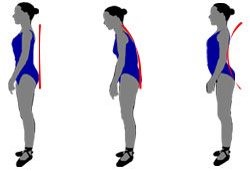The Core is the foundation for all movements and the axis of
power of the kinetic chain. It maintains strength, stability and mobility of
the spine, in addition to stabilising the thoracic cage and pelvis during movement.
Good alignment and posture is essential for the dancer. This requires muscles, joints and motor components to work together to produce optimal results. Thus it is important to have correct static posture and movement efficiency prior to considering movement.
But what is good posture? Good posture is when there is an equilibrium
within the body. That is, a balance of muscular control at each joint. For
example, turnout for the classical dancer requires balanced muscular control
through careful coaching. Incorrect posture or a misunderstanding of classical
posture through bad coaching may lead to muscle imbalance, which is a common
cause of injury within the dancing population.
Correct muscle balance is as important as having muscle
strength. Without it, strength is of little value as ‘cheat’ movements may occur
to reach the end goal. These imbalances must be ironed out. Muscular imbalances
can be looked for between-
1.
One side of the body and the other. For example,
you are able to single leg squat on the right leg 12 times but only 5 times on
the left leg.
2.
One side of the limb and the other. For example,
a hamstring tightness causing posterior pelvic tilt or tight hip flexors
causing an anterior pelvic tilt.
3.
Between various muscle groups controlling the
movement of a particular joint. For example, imbalance of the quadriceps can
lead to patella maltraction and consequently anterior knee pain.
The trunk, made up of the ribcage, spine and pelvis, is the
basis for good posture and correct movement patterns. If this base is solid, in
that it is well aligned, then the hips will move more efficiently and the
shoulder girdle will also function more efficiently at the top. Everything has
a cause and effect in the body’s kinetic chain.
There are many ways to build core strength and challenge
alignment for the dancer. Come back to find out in the next post.
Start Strong, Finish Stronger





I am very enjoyed for this blog. Its an informative topic. It help me very much to solve some problems. Its opportunity are so fantastic and working style so speedy.
ReplyDeleteSports Massage Bournemouth